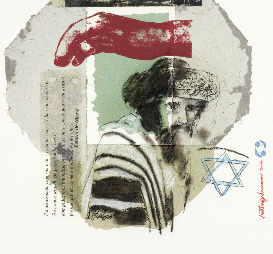Toma mis obras en favor de tu Pueblo: El sacrificio a la luz del judaísmo según Borges
DOI:
https://doi.org/10.17851/1982-3053.12.23.32-51Palavras-chave:
Reformulación, Intertextualidad, Exégesis.Resumo
En el siguiente trabajo veremos cómo es que Borges retoma el rol histórico que se ha adjudicado la colectividad judía como pueblo elegido para configurar muchas de sus tramas y protagonistas. La ofrenda sangrienta interesa al autor no solo por su naturaleza atávica y bárbara, sino también por su carácter ritual y místico: el sacrificio permite, tanto para el tributo como para los que lo ofrecen, estrechar y reavivar los lazos con la Divinidad.
Downloads
Referências
AGUS, Aharón. The Binding of Isaac & Messiah. Law, Martyrdom and Deliverance in Early Rabbinic Religiosity. New York: SUNY Press, 1988.
ALLPORT, Gordon W. La naturaleza del prejuicio. Trad. Ricardo Malfé. Buenos Aires: EUdeBA, 1977.
BARTH, Frederik. Los grupos étnicos y sus fronteras. Trad. Sergio Lugo Rendón. México D. F.: FCE, 1976.
BANTON, Michael. Modelling ethnic and national relations. Ethnic and Racial Studies 17.1, p. 1-19, 1994.
BORGES, Jorge Luis. Obras Completas. 1923-1972. Buenos Aires: Emecé, 1984.
BORGES, Jorge Luis. Ficciones. Buenos Aires: Emecé, 1999.
BORGES, Jorge Luis. El Aleph. Buenos Aires: Emecé, 2005.
BORGES, Jorge Luis. El libro de arena. Buenos Aires: Alianza Editorial, 2008.
BOYER, Alain; HAYOUN, Maurice Ruben. La historiografía judía. Trad. Paula López Caballero. México D. F.: Fondo de Cultura Económca, 2008.
BROW, James. Notes on Community, Hegemony and uses of the Past. Antropological Quarterly 63.1, p. 1-7, 1990.
COLLINS, John J. Between Athens and Jerusalem. Jewish identity in the Hellenistic Diaspora. Livonia: W. B. Eerdman's Publishing Co, 2000.
COMAROFF, John L.; COMAROFF, Jean. Ethnicity Inc. Chicago: The University of Chicago Press, 2009.
ECO, Umberto. Construir al enemigo y otros escritos. Trad. Helena Lozano Miralles. Buenos Aires: Sudamericana, 2013.
ELIADE, Mircea. Mito y realidad. Trad. Luis Gil. Barcelona: Labor, 1992.
FARMER, William Reuben. Maccabees, Zealots and Josephus. An inquiry into Jewish Nationalism in the Greco-Roman Period. New York: Columbia University Press, 1958.
FRENKEL, Diana Lea. El martirio en la Septuaginta: II y IV Macabeos, Anales de Filología Clásica 24, p. 59-91, 2011a.
FRENKEL, Diana Lea. La institución de la monarquía en el relato bíblico”. Stylos 20, p. 7-34, 2011b.
GRABBE, Lester. L. An Introduction to Second Temple Judaism. London: T&T Clark, 2010.
LAMM, Norman; BEN SASSON, Haim Hillel. Kiddush haShem and Hillul haShem. En: BEREMBAUM, M. & SKOLNIK, F. Encyclopaedia Judaica. V. 12. Detroit, p. 139-145, 2009. Disponible en: http://www.jewishvirtuallibrary.org/jsource/ judaica/ejud_0002_0012_0_11109.html. Acceso en: 11 set. 2012.
LEFERE, Robin. Borges y los poderes de la literatura. Bern: Long, 1998.
MALEŠEVIĆ, Siniša. The Sociology of Ethnicity. London: Sage, 2004.
MOORE, Stephen D.; Anderson, Janice Capel. Taking it like a man: Masculinity in 4 Maccabees. Journal of Biblical Literature 126/1, p. 99-127, 1998.
PIÑERO, Antonio. Literatura judía de época helenística en lengua griega. Madrid: Síntesis, 2007.
RAHLFS, Alfred (Ed.). Septuaginta, id est Vetus Testamentum graecae iuxta LXX interpretes v. 1-2 [1935]. Stuttgart: Württembergische Bibelanstalt, 1971.
RIVERA, Jorge B. Los juegos de un tímido: Borges en el suplemento de Crítica. Crisis, n. 4, mayo-junio, p. 34-35, 1976.
SACCHI, Paolo. Historia del judaísmo en la época del segundo templo. Trad. Carlos Castillo Mattasoglio y Adela Sánchez Rojas. Madrid: Trotta, 2004.
SAULNIER, Christiane. La crisis macabea. Trad. Nicolás Darrical. Estella: Verbo Divino, 1983.
SAYAR, Roberto Jesús. He dicho: pueblo salvado. Esquemas narrativos y jurisprudencia en IV Macabeos en Neyra. En: NEYRA, Andrea Vanina; PÉGOLO, Liliana (Coord.) Un milenio de contar historias II. Los conceptos de ficcionalización y narración de la Antigüedad al Medioevo. Buenos Aires: Editorial de la Facultad de Filosofía y Letras, UBA [En prensa], 2018.
SAYAR, Roberto Jesús. Realmente en ti está Dios escondido (Is. 45.15). Historicidad y valor del testimonio en IV Macabeos [en línea]. Congreso Internacional de Literatura, Estética y Teología “El amado en el amante: figuras, textos y estilos del amor hecho historia”, 17-19 mayo 2016. Universidad Católica Argentina. FFyL. FT; ALALiTe, Buenos Aires. Disponible en: . Acesso en: 10 nov. 2018.
SAYAR, Roberto Jesús. Te voy a poner como una luz para el mundo (Is. 49.6.4). La figura de Eleazar como ejemplo y paradigma del éthnos hebreo en IV Macabeos. Anales de Filología Clásica 27, p. 99-114, 2014.
SCHIFFMAN, Lawrence H. The early history of public reading of the Torah. En: FINE, S. (Ed.). Jews, Chistians and Polytheists in the Ancient Synagogue. London/New York: Routledge, 2005. p. 38-49.
SHEPKARU, Shmuel. From after Death to Afterlife: Martyrdom and its recompense, Association for Jewish Studies Review 24/1, p. 1-44, 1999.
SOSNOWSKI, Saúl. Borges y la cábala. La búsqueda del verbo. Buenos Aires: Hispamérica, 1976.
VAN HENTEN, Jan Willem; AVEMARIE, Fiedrich. Martyrdom and Noble Death. Selected Texts from Graeco-Roman, Jewish and Christian Antiquity. London/New York: Routledge, 2002.
VAN HENTEN, Jan Willem. Judith as Alternative Leader: A rereading of Judith 7-13. En: BRENNER, A. (Ed.). A Feminist Companion to Esther, Judith and Susanna. Sheffield, 1995. p. 224-252.
Downloads
Publicado
Edição
Seção
Licença
O autor cede os direitos autorais à revista Arquivo Maaravi. Os direitos de licenciamento utilizados pelo periódico estão sob a Licença Creative Commons do tipo atribuição BY: são permitidos o compartilhamento (cópia e distribuição do material em qualquer meio ou formato) e adaptação (remix, transformação e criação de material a partir do conteúdo assim licenciado para quaisquer fins, inclusive comerciais.











